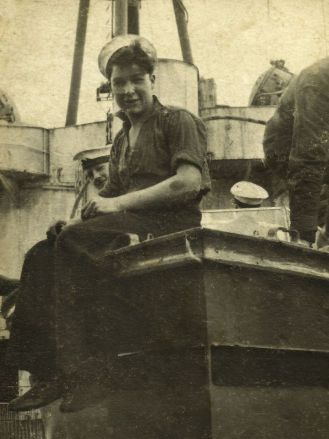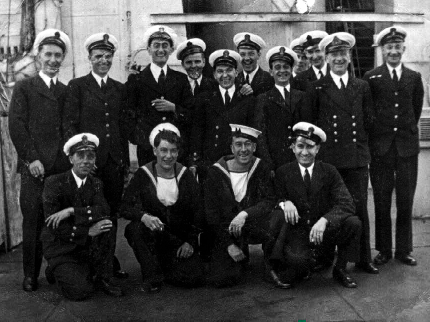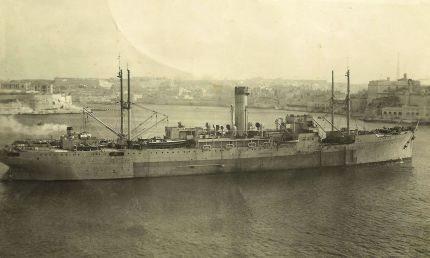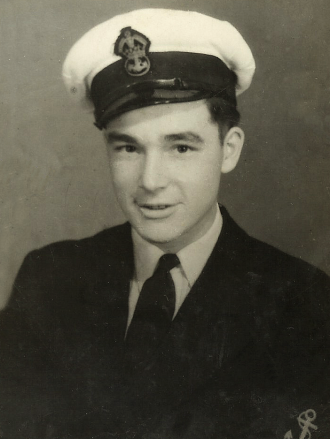
Ordinary Seaman George, RN
A neighbour of mine, George, served in the Royal Navy on HMS Birmingham (pennant number C19) during the Second World War. The Birmingham was a light cruiser built at Devonport Dockyard and launched in 1936. She had a displacement of 91,000 tons, a top speed of 32 knots and her main armament consisted of 12 x 6in guns, three in each of four turrets.
George joined the Birmingham as an ordinary seaman in June 1943, while the ship was undergoing a refit. Before the refit, Birmingham carried two Supermarine Walrus float planes. These were used for spotter duties and also could be used in a search and rescue role. They were launched by catapult and after the patrol they would land in the sea to be lifted onto the ship by a derrick and stored in a hangar amidships.
Retrieving these aircraft was an awkward operation which left the ship vulnerable to U-boat attack as the ship had to slow down while the aircraft was hooked and lifted by the derrick. Also at this point in the war the Royal Navy was acquiring more and more escort and fleet aircraft carriers equipped with more advanced aircraft making the Walrus redundant.
Part of the refit was to remove the aircraft, the catapult and convert the hangar into mess decks. The work was completed in October 1943 and the ship sailed to Scapa Flow in the Orkney Islands for trials.
At Scapa Flow George was attached to the Shipwright’s party, a group of skilled tradesmen of various disciplines and he worked as the welder’s mate. This was a really good piece of fortune for him because as an ordinary seaman George could be ordered to carry out any kind of hated dogsbody task such as swabbing the decks or painting the ship. Painting was a hated task especially the hull.
Painting the bow was particularly difficult because here the side of the vessel curves inwards. Hanging straight down in a bosun’s chair, the sailors would have to swing to and fro until they could daub the hull with a splodge of paint, then kick themselves away to swing back in. George and his shipmates would make the best of it, often ‘larking about’ and ending up putting more paint on each other than on the ship! Being attached to the shipwrights released him of these mundane duties.
HMS Birmingham, under the command of Captain Blackburn, was assigned to be part of the escort for Convoy KMF26 to the Mediterranean. When the convoy reached the Strait of Gibraltar in fine weather, Birmingham made for the port arriving at 08:00 on Wednesday 24 November 1943, while the bulk of the convoy continued into the Mediterranean. The next day the Birmingham was ordered to sea at 22:00 to continue alone heading for the eastern Mediterranean at a cruising speed of around 26 knots.
The sea was calm and the weather fine as the Birmingham rode along the favourable easterly current of the southern Mediterranean. Much of the time George would have been at his cruising station as gun loader on a twin Oerlikon anti-aircraft cannon on the starboard side of the Birmingham. At battle stations however, he had to take up a different position which was a single Oerlikon cannon on a different deck but still on the starboard side. George never understood the logic to this arrangement.
George on HMS Birmingham
It should be noted that the North African Campaign had ended in May 1943 so there was no danger of air attack by land-based enemy aircraft from the south. The Allied invasion of Sicily began on 9 June and the island was secured on 17 August. The Allied campaign on Italy had begun on 10 July and was well under way. Sardinia had been evacuated by the Germans in September and soon after they were forced out of Corsica to the north.
However, the Birmingham would have to go through the bottlenecks between the islands of Sardinia and Sicily and the North African coast of Tunisia. The gap is a mere 78 nautical miles (90 miles) at its narrowest, the Strait of Sicily, between Sicily and Tunisia. This was well within range of Italian and German bombers from mainland Italy or even Southern France. The lack of sea room caused by the bottleneck was a favourite area for the Axis air forces to hunt for Allied shipping especially if they had good intelligence of ship movements from Spanish spies at Gibraltar.
An example of such an attack presented itself as Birmingham sailed along the North African coast of Morocco. Some distance ahead, off the coast of French Algeria, Convoy KMF26 was bound for Alexandria. On 25 November the troopship HMT Rohna, carrying 2,015 US troops, joined the convoy with four other ships having sailed out of the port of Oran.
At about 16:30 the next day, the convoy was attacked by some Heinkel He111 torpedo bombers, Junkers Ju88s and about 30 Heinkel He177 bombers each carrying two of the new Henschel Hs293 radio-guided glide bombs. Air support for the convoy was just four Free French Spitfires later relieved by RAF Spitfires. Eight aircraft were reported to have been shot down.
In the confusion of the air attack, one of the He177 aircraft released a glide bomb at about 17:20 and it struck HMT Rohna on its port side near the engine room. It flooded the engine room and knocked out the electrical systems which meant the water pumps didn’t work. The explosion also destroyed six out of the ship’s 22 lifeboats. Damaged plates on the hull meant that none of the lifeboats on the port side could be lowered.
The US troops didn’t know how to lower the other lifeboats so they cut the suspension ropes with their bayonets. Lifeboats hit the sea uncontrollably and immediately became waterlogged and useless. Only eight boats were successfully launched but they soon became overloaded and some capsized. The ship was now ablaze. It must have been utter chaos.
Various ships fell back from the convoy including HMS Atherstone which provided a smokescreen and anti-aircraft cover and later rescued some of the survivors. The Rohna finally sank about an hour a half later with the loss of 1,138 men, 1,015 being US personnel and 123 crew. A further 35 troops died later from injuries sustained in the attack. It was, and still is, the largest single incident loss of US troops at sea due to enemy action. The Birmingham was yet to sail through this potential hell.
Thankfully, the Birmingham avoided any serious attack from the air, possibly because it was travelling alone and, at around 26 knots, was moving at about two and a half times faster than the speed of any convoy. After a brief stop off at Malta, the Birmingham left port to sail alone again, now bound for the Suez Canal and ultimately the Far East. Much of the voyage through the Mediterranean was fine weather with calm seas and the ship was making about 26 knots.
George, bottom inside left, with the shipwrights on the hangar deck
The morning of Sunday 28 November brought fine sunny weather and a blue sky. The bow waves curled over as the Birmingham cut cleanly through the water of the Mediterranean, cruising along the coast of Libya which was, as with all of North Africa, safely in the hands of the Allies. In this idyllic calm Mediterranean morning, the war must have seemed a thousand miles away. Indeed, with every nautical mile made, the ship was moving further and further from the main action in Italy. It was 11:18 and the ship was just off the coast of Cyrenaica, Libya. Sunny, warm and a calm sea.
The day was shattered by a huge explosion that lifted and rocked the ship violently. Men were blown over the side, several of them were already dead. Panic set in as sailors rushed to the upper decks. The order was given ‘Hands on watch stand fast! – off watch to emergency stations!’. Unlike the Rohna, which had been hit at the engine room, there were no substantial fires and the situation was nothing like as desperate so there didn’t seem to be an immediate need to abandon ship. The location was 33°05’N 21°43’E.
Initial speculation was that the ship had hit a mine but it soon became clear that it had been torpedoed by a German submarine. Once the Captain had made his assessment the ship got under way to escape this dangerous location. As soon as the U-boat had fired its torpedo it would have gone down to skulk in the deep but it would soon be back up to periscope depth to assess the damage to the ship and possibly make another attack.
The speed of the Birmingham was reduced to 10-14 knots, the underwater speed of the submarine was 7·6 knots but its surface speed at night was 17·6 knots. The Birmingham had to gain as much distance before dusk in case the submarine gave chase. Two destroyers had left Convoy KMF26 to provide protection and 10 aircraft also attended, one of which dropped depth charges.
The U-boat was U-407. The standard torpedo of the time carried a warhead of 280kg of an explosive mixture which included 67% trinitrotoluene (TNT).
George has no memory of how he got to the upper deck. At the moment the torpedo struck he may have slipped, fallen and struck his head on something hard, perhaps a railing or a bulkhead and been helped to the upper deck but he had no bruising. He may have suffered as a result of gas poisoning from the explosion but he hasn’t suffered any long term effects.
It’s quite likely that he may have suffered temporary amnesia. The medical term is transient global amnesia and can occur at high levels of stress or trauma. Whatever it was, the first he was aware of the torpedo attack was when he regained his senses on the upper deck. The wounded were gathered together, on stretchers if necessary, in the mess that had previously been the aircraft hangar. The death toll came to 30 sailors.
In the old hangar George found one of his shipmates Charlie, lying down with his eyes closed. George had known Charlie since his early childhood, growing up in the same street in London. They lost touch but were reunited at HMS Collingwood, Fareham where Charlie was next in line to George to collect their pay books. They spent 10 weeks training then both were assigned to the Birmingham. Even their cruising stations were near each other at No 8 (George) and No 9 (Charlie) twin Oerlikons amidships near the rear funnel and ASDIC mast.
Charlie was suspected of suffering gas poisoning from the explosion and had a casualty label on his shirt. George shook him and said ‘Charlie, are you alright?’ Charlie opened his eyes and George carried on ‘what’s up with you?’ Charlie sat up, checked himself out and said ‘Nothing.’ He tore his casualty label off, got up and walked out on deck with George.
Gas poisoning could affect a person to varying degrees largely dependent on the length of exposure. Some people might suffer serious mental problems for the rest of their lives. Sadly, as George found out later, his own boss, the welder shipwright, had suffered from gas poisoning and had completely lost his memory.
The torpedo had struck the port bow and the ships bow was down in the water by about twelve feet. Seriously damaged with neither forward turrets working, the Birmingham tentatively continued its voyage eastwards through the Mediterranean.
Sailing at 26 knots, the Birmingham should have been relatively safe from torpedo attack. There was speculation that the progress of the ship may have been monitored by Spanish spies sympathetic to Germany at Gibraltar, and by Sicilian spies working for the Italians and Germans at Malta.
The captain made an announcement to the crew that if the ship’s condition worsened he would order the beaching of the ship on the North African Coast. Air cover was provided until the ship could catch up with Convoy KMF26 ahead. Ironically it was now under the protection of the convoy that it had originally been dispatched to escort from the North Atlantic.
That night the ships company was tense. Some of the crew tried to sleep but the anxiety was high and some of them lay restlessly in their hammocks with their lifejackets already inflated fearing a night attack from the U-boat. Thankfully Birmingham managed to reach Alexandria for temporary repairs on the morning of Tuesday 30 November.
The map shows the main areas of occupation around the Mediterranean by November 1943. Allied occupation is shown in blue, Axis powers in red and neutral in orange. Some Italian forces had already started to surrender, rebel or defect to the Allies. The location of the submarine attack on the Birmingham has been given as 33°05’N 21°43’E off the coast of Cyrenaica, Libya.
The ship was put into a dry dock and three dead men were still trapped in the lower decks of the ship where the torpedo struck and they needed to be recovered. Damage within the ship meant that they couldn’t be accessed in any normal manner. The only way to get at the bodies was to cut away the warped and twisted bulkheads and girders etc using a gas torch.
Since the welder shipwright had suffered from gas poisoning and was completely unfit for duty, George was now the only member of the crew that could use gas cutting equipment. He was given the task of cutting away the obstructions so that the three dead bodies could be recovered.
With the ship in dry dock, George was lowered into the hull on a bosun’s chair to the area where the dead bodies were. A bosun’s chair was a crude device typically consisting of a board of wood to sit on suspended by four ropes spliced in some way into one suspension rope. They were normally used to lower a sailor over the side of a vessel for painting. More sophisticated types were used to transfer a person to another vessel by way of a connecting rope or cable.
It was quite a precarious arrangement with the main rope suspended from a pulley hung from an A frame or a convenient girder. As George was lowered into the ship he had to wrap his arms around the four ropes attached to the board for his safety, holding on to his gas torch. He was lowered three or four times, each time for up to ten minutes and he found it difficult to use the torch from an unstable platform.
Right: A bosun’s chair of the type George used
Although George was not to have anything to do with removing the bodies, the anticipation of what he might see of the possibly gruesome condition of the dead men must have been quite a worry. His very real concern however, was that he had to work dressed in pants and a vest with nothing to protect his skin from the sparks that splash around when cutting steel with gas.
Thankfully all he had to do was cut through metal, then he was raised back up while the material was removed. The officers would then consider what to do next and George would be lowered in again to make the next cuts. He didn’t see anything gruesome, the bodies were removed by other sailors.
The Birmingham was hastily repaired at Alexandria before sailing to the USA in June 1944 for more permanent repairs which were completed in November 1944. She returned to Britain to join the 10th Cruiser Squadron at Scapa Flow and in 1952 she was sent to Korea. In 1956 the Birmingham starred in the films The Baby and the Battleship starring John Mills; and The Battle of the River Plate starring Anthony Quayle. The ship was scrapped in 1960.
HMS Blenheim
George had already parted company with the Birmingham to serve on the submarine depot ship HMS Blenheim. The Blenheim was originally the freighter SS Achilles but there was already a HMS Achilles in service with the Royal Navy so the name had to be changed.
Photo courtesy of George
HMS Blenheim Pictured entering Valetta, Malta, on 18 February 1946 on the way home to the UK
The Blenheim was permanently stationed at the dockside in the port of Alexandria for the duration. Sometimes it would put to sea for a day or so when a submarine needed to do sea trials after repair or overhaul. Mostly it was moored at the dockside often with three or four other ships tied up alongside which may also have needed the services of the Blenheim.
The Blenheim had a displacement of 16,600 tons, a top speed of 14 knots and main defensive armament of 4 x 4in anti-aircraft guns. The Blenheim was scrapped in 1948.
The Blenheim was commanded by Captain Charles Maurice Blackman DSO (retired). Among his previous commands were the Town class light cruisers HMS Belfast and HMS Edinburgh.
George became a Probationary Engine Room Mechanic (PERM) and served as welder with the Blenheim’s shipwrights. He rose to the rank of Petty Officer while he was still just 19 years old. He was quite possibly the youngest petty officer in the Royal Navy at that time.
George allowed me to read his Certificate of the Service in the Royal Navy, (more commonly known as Discharge Papers) and it shows an impressive service history. It’s a four page document and the last page is a record of conduct. Under the heading ‘character’ each entry is ‘very good’ and this was the highest grade that could be awarded. Under the heading ‘efficiency’ most entries are given as ‘satisfactory’ with one ‘superior’ which was a very rare award especially for someone so young.
George as a Probationary Engine Room Mechanic prior to becoming a Petty Officer
I am very grateful to my very good friend George for his help in producing this article and I dedicate it to him.
Gary Flint
My name is Gary Flint. I'm author, photographer & illustrator for Postcards from Slough. If you wish to make any comments on the contents of the website please click on the ladybird below:
Gary Flint
08/03/1961 - 09/04/2019
Postcards from Slough is an independently funded website. We are open to offers of sponsorship from companies that have any connections to the town. To contact us please click on the ladybird below:
Chalvey Community Forum
Postcards from Slough is linked with a local action group the Chalvey Community Forum. The group liaises with various local organisations in order to improve the quality of life for residents in the ward of Chalvey and Salt Hill. To learn more please click on the maidenhair leaf below:
Museum of Berkshire Aviation
I volunteer as a guide at the Museum of Berkshire Aviation. It is a special museum and if you would like to know more about the museum then please click on the motif below:
To learn more about the museums activities while staying within this website click on the tab at the top of the page or on the motif below:
Graces Guide
Postcards from Slough uses some images from Grace's Guide. Click on the button below:
British Listed Buildings
Postcards from Slough contributes material to British Listed Buildings and uses the site for cross referencing purposes. Click on the button below:








